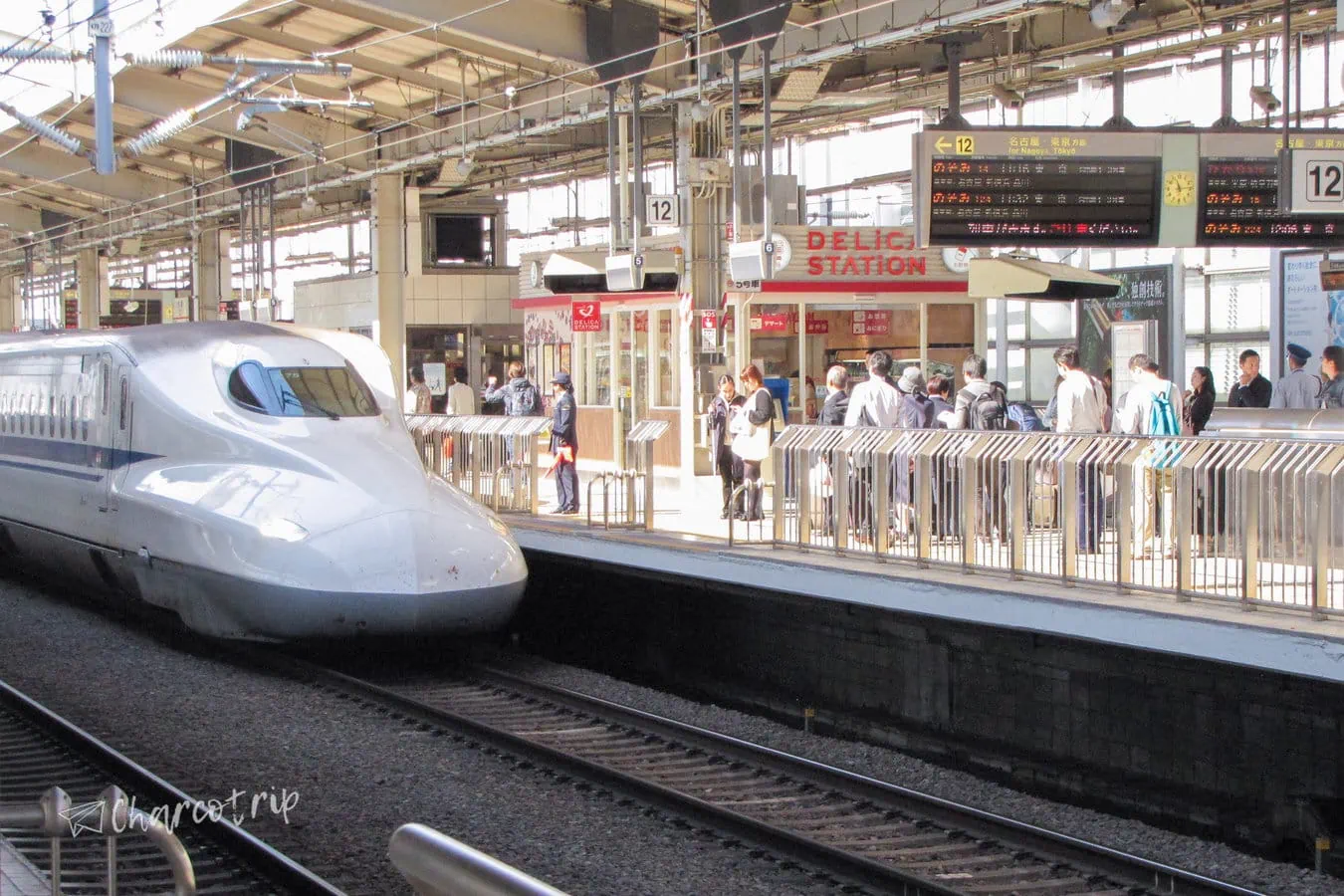Explore the typical food in Japan! From sushi to sake, discover more than 30 traditional Japanese delicacies to try on your trip.
Japan is a country famous for its temples, landscapes, modern cities, as well as its delicious cuisine, and visiting it without trying it would be a shame. From the savory to the sweet, from the traditional to the modern, the country of the rising sun offers a wide variety of dishes and delicacies that will appeal to all types of diners. In this article, we will explore more than 30 different dishes, so you can see what are your possibilities of typical food to eat while traveling in Japan.
How do you know what food to order?
Language can be a barrier when it comes to eating and the Japanese themselves, who are used to receiving foreign visitors, know it. For this reason, it is not uncommon to find in many restaurants different ways to order food without having to talk, or talk a lot, in addition to the fact that menus are often quite visual, or you can even see very realistic and tasty models of the dishes, like the one in the photo below.
So, if you wonder what to eat in Japan, you know you want to try typical food, but you’re confused by trying to read the menu, let yourself be carried away by your eyes, they say that love is born from sight.
Food models
Making food models is not only for foreigners, it is something that has been done for a long time and is anchored in modern Japanese culture. The techniques to create these “replicas” of food have been improving over time, and the truth is that the results are wonderful.
As a curiosity, there are some shops where you can buy souvenirs related to these culinary models. A delicious, though inedible, souvenir of typical food of Japan to put in your fridge as a magnet.
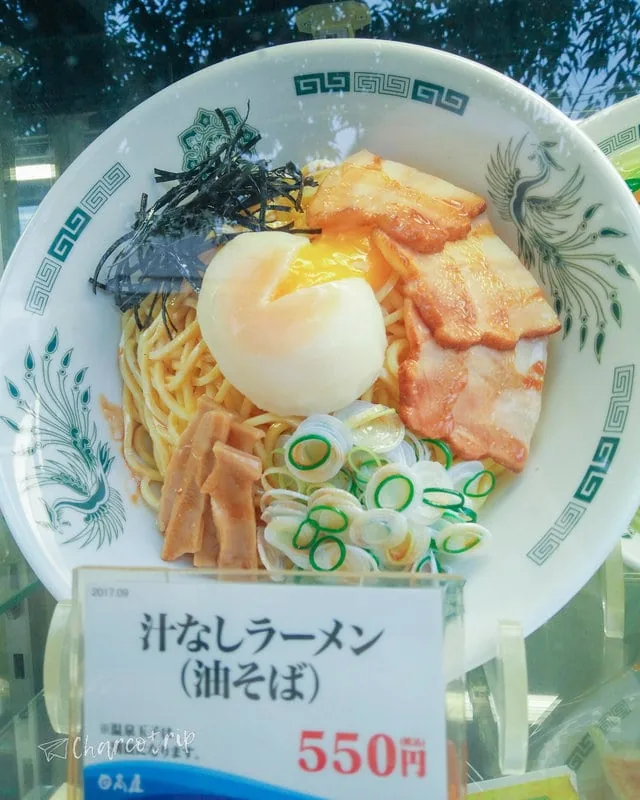
The vending machine
In some restaurants, especially in the ramen ones, you can find little machines where you can order and pay for what you are going to eat. The little machine gives you a ticket, and you simply hand it over to the person in charge. Easy.
On other occasions, if there is no machine at the entrance, there may be a tablet on the table from which you can order, but here yes, you will have to pay later at the normal cashier.
But what can I do if there is no model or machine?
It can also happen that you arrive at the restaurant and everything is more traditional, that is, a menu from which you have to choose and ask the person in charge.
You have three options, either the menu has photos, and you feel confident enough to order, there you go, the second would be to use the Google Lens app to try to understand whatever is written.
The third option would be to ask for an English menu. Don’t be ashamed. You just have to ask for it like this:
Ego no menu o kudasai (英語のメニューをください)
Do not worry about not understanding the response of your interlocutor, if they do not have it, they will apologize for not having it, but if they do, they will bring it to you immediately.
How do I order?
Don’t worry, if you can’t order like you would in a restaurant back home, the Japanese are very understanding, and you just have to show what you want on the menu. If you want to say a word when pointing to the food you want, you could ask it like this:
Kore (これ)
And if you want to show something else, just say “TO” after, which means “and”. For example, if you order two items from the menu, pointing at them, you can say “kore” (pointing to the first item) “to” (to indicate that you will order something else) kore (and pointing to another item). Don’t forget to add the words “o kudasai” which mean “please”.
Looking for a flight to Japan?
Book your tickets at the best price here!
Exploring the typical food in Japan, let’s go in parts
Now, yes, we are going to give you a tour of this list of foods that you will surely come across on your trip to Japan.
Typical food in Japan for breakfast
Natto (なっとう)
Natto beans is one of most typical food you can find in Japan for breakfast. It is a type of fermented soybean that has a sticky, viscous texture and an acquired taste, as well as a strong odor.
One of the stories about its origin tells that a samurai was boiling these beans, but suddenly, he had to flee with his soldiers because they were assaulted, the days passed, and the beans became smelly and slimy. They bravely tried them and apparently liked them.
Natto is made by boiling soybeans and then fermenting them with the bacteria Bacillus subtilis natto. Many Japanese like to eat this dish regularly for breakfast, garnished with mustard and soy sauce, accompanied by white rice.
I tried these beans on my first trip to Japan, and I honestly said to myself, “oh, they’re beans, they can’t be bad.” They smelled ugly, they were slimy, but even so, I tried them and discovered that there were some beans that I didn’t like XD.
But if you travel to Japan, go ahead and eat natto!

Yoshinoya’s Breakfast
In the Yoshinoya chain, we can find various breakfast menus. In case you’re between “I want to try Japanese food, but I’m not ready to do it completely yet”, a breakfast like this is perfect.
You have the miso soup, rice (instead of bread), and protein-wise you have eggs with ham, in a more traditional version this would be replaced by salmon. In addition to a portion of meat and salad.
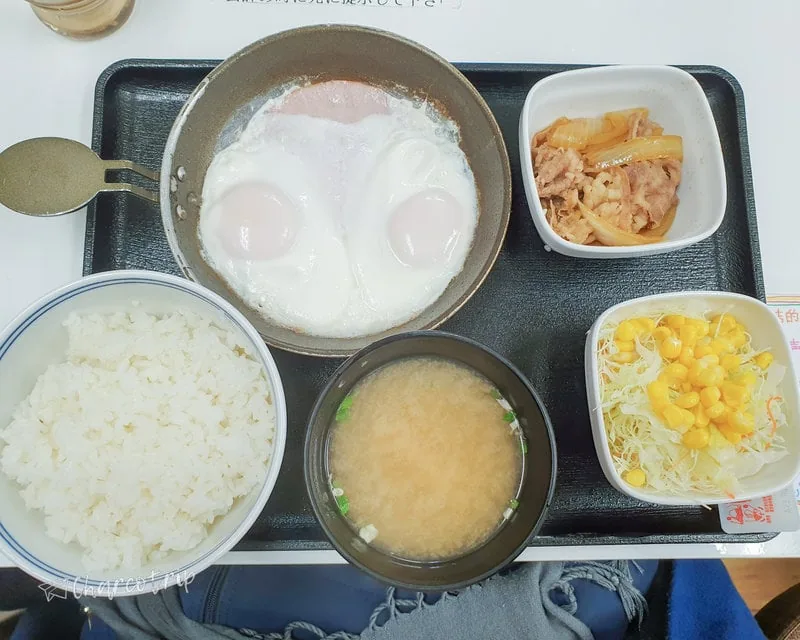
Japanese starters
Tempura (てんぷら)
Tempura is a popular Japanese dish loved by locals and tourists alike. It is prepared by frying vegetables or seafood in a wheat flour batter, making them crispy and light. In addition to its texture, tempura also boasts a variety of flavors that tantalize the taste buds, whether enjoyed as part of a multi-course meal or simply on its own, it can be an unforgettable culinary experience.
To get the full effect of this classic Japanese dish, pair it with various dipping sauces, such as tare sauce or shoyu, for additional depth and flavor.
In my case, I have eaten the tempura as a starter or with a good udon, delicious. With so many variations available throughout Japan, tempura is a must-try for any foodie visiting the country!
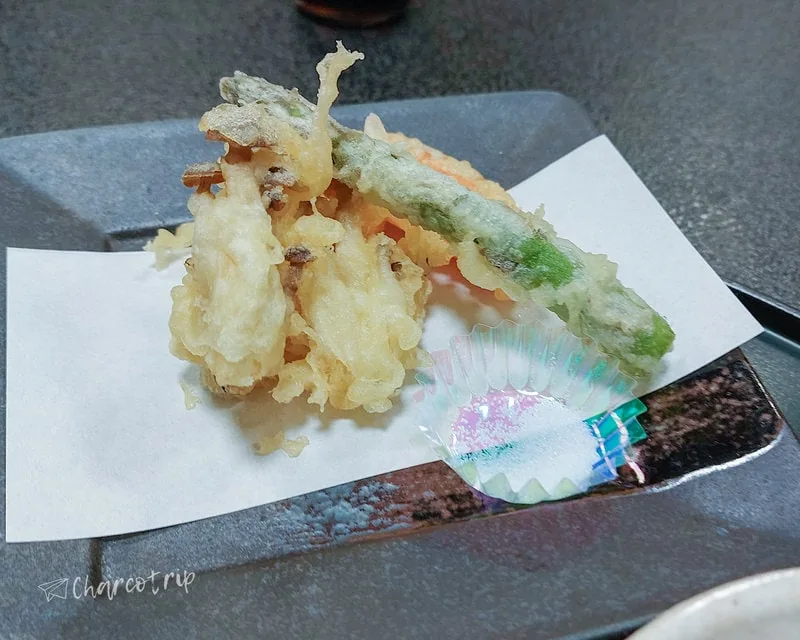
Miso soup (味噌汁)
Miso soup is a travel essential for anyone coming to Japan. It is made from a dashi broth and miso paste, which gives it its name. Miso soup comes in many varieties depending on the region of Japan where it is served and can be light or dark brown and can include a variety of ingredients such as seaweed, tofu, onions, mushrooms, and clams.
This soup can be eaten at any time of the day, from breakfast to dinner. In my case, when I eat this soup, its flavor makes me feel that I’m in Japan.
Let’s see some fast or street food
Oyaki (おやき)
Oyaki is a traditional Japanese dish found in many regions of Japan. In our case, we tried it in Nagano, where it is part of the traditional foods of Shinshu (which is what the region was called before).
It consists of a small, flavorful dumpling that is usually stuffed with vegetables and then steamed or grilled. The balls are usually served hot and can be made with buckwheat flour, wheat flour, rice flour, or any combination of the three.
Although they do not constitute a complete meal, they are a quick and tasty meal that fills the stomach at the moment. We loved them.
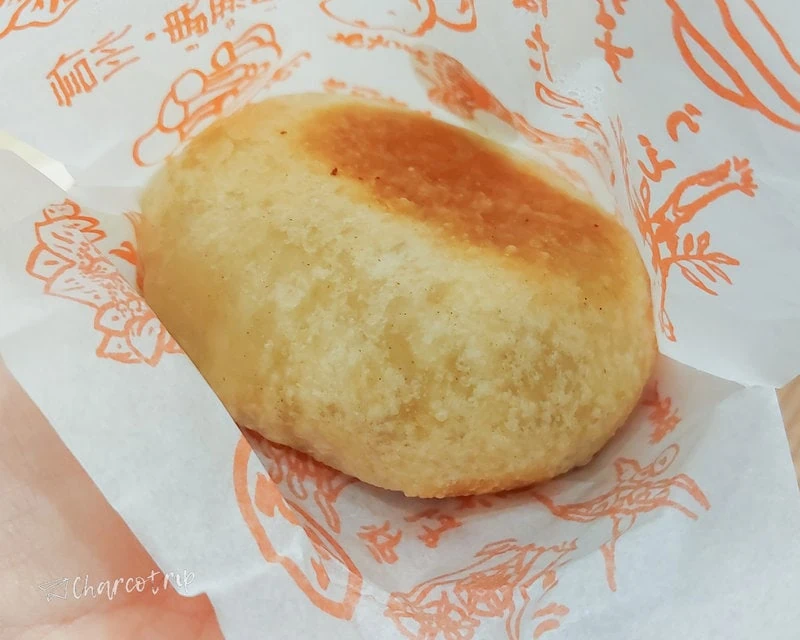
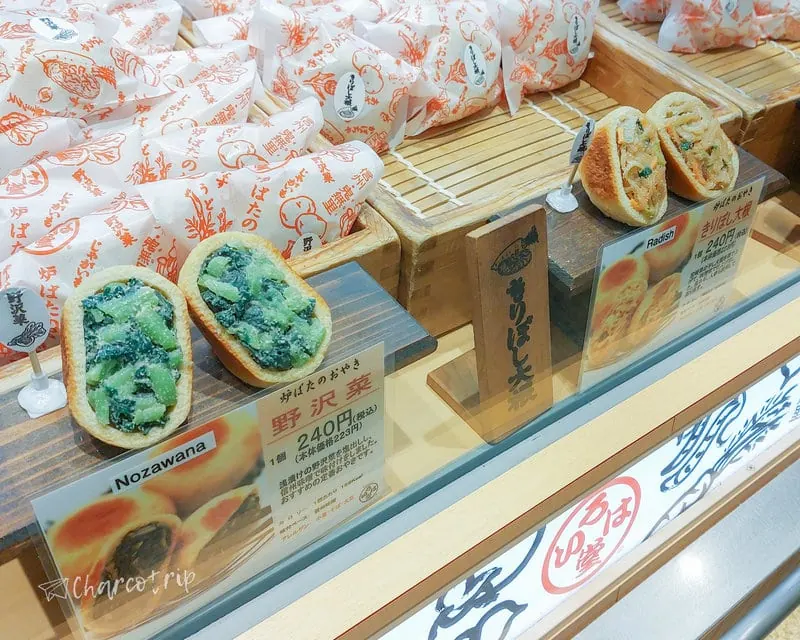
Onigiri (お握り)
Onigiri, or rice balls, are delicious snacks, they come in many different shapes and sizes, from the classic triangle to more unique shapes like eggs, hearts, and even animals. They are usually filled with savory fillings like salmon flakes, pickled plums, or fermented soybeans, but there’s no limit to what you can find inside!
Onigiri is a perfect way to eat on the go: it’s portable, filling, and best of all, affordable. It is easy to find in most convenience stores or supermarkets throughout the country, so be sure to eat onigri during your trip to Japan.
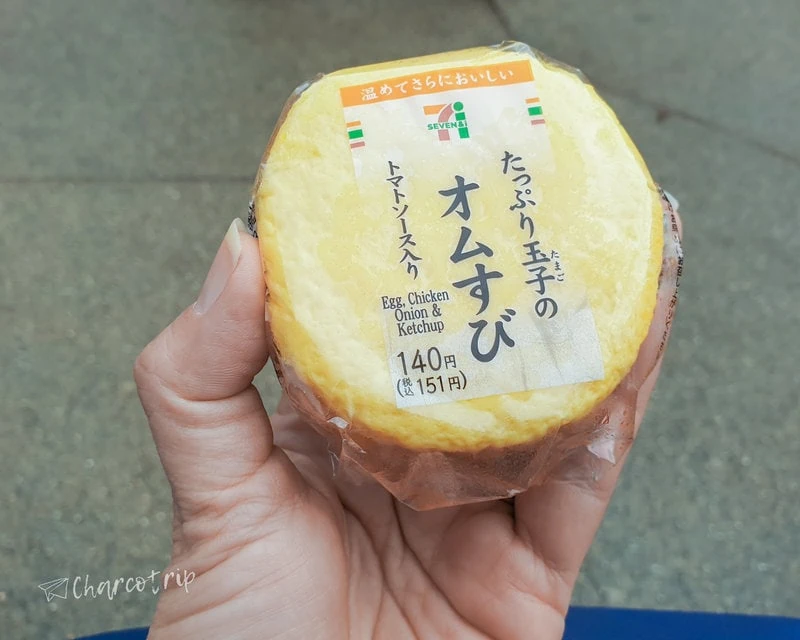
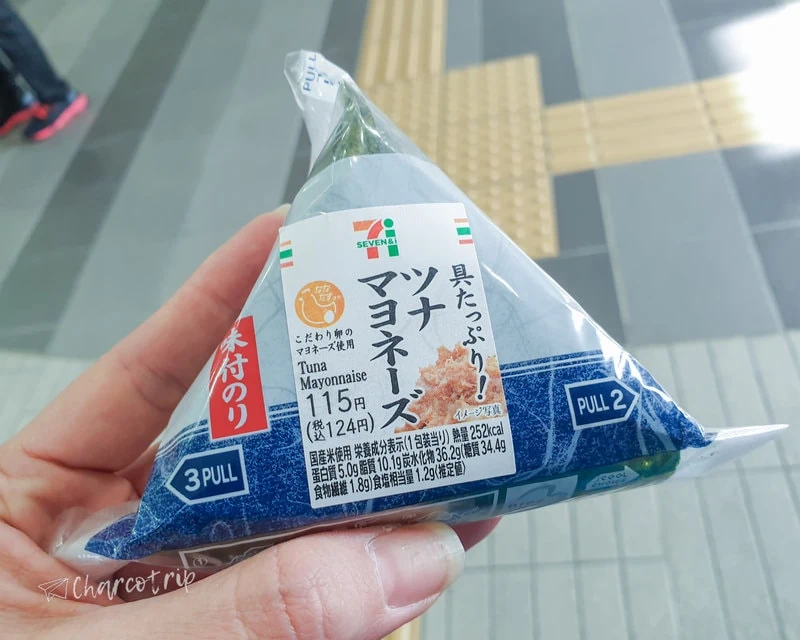
Hamburgers
I know it’s weird to suggest hamburgers, but as happened on the occasion when we told you about the typical food in France, here in Japan we were able to find hamburgers with a very particular style and combined with flavors from the country.
In this case, we will refer to a particular hamburger chain, called Mos Burguer (モスバーガ), here we were able to try hamburgers with teriyaki sauce or rice bread. Delicious, and they save our stomachs when the more traditional food places are full.

Ekiben (駅弁)
If you really want to experience an original aspect of Japanese cuisine, don’t miss the ekiben, an iconic bento box sold at train stations across the country.
Ekiben are packed with local delicacies and specialties from different regions of Japan. You can find everything from sashimi to tempura, onigiri (rice balls) and savory snacks like takoyaki (octopus dumplings). Each ekiben is designed with regional flavors and ingredients in mind, so they’re a great way to explore the culture of Japan while enjoying delicious food.
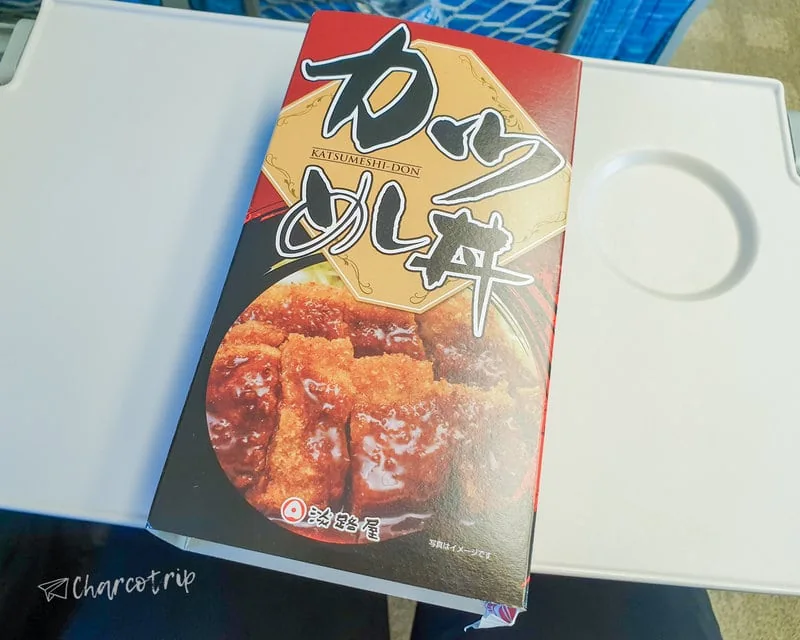
Takoyaki (たこ焼き)
Takoyaki is a popular snack that has been delighting locals and tourists for many years, and is typical of the Kansai. It is a savory delight made from wheat flour battered with pieces of octopus, tempura leftovers, pickled ginger and spring onion cooked in a special pan with small round molds.
The taste is unique and tasty, like nothing you’ve ever experienced before! The best way to enjoy it is at street stalls and food stalls at festivals or special events.
Eating it hot off the grill is always the best way to go, be sure to slather on some of their famous takoyaki sauce, which makes it even more delicious!
These are just some of the typical fast food you can try while in Japan!
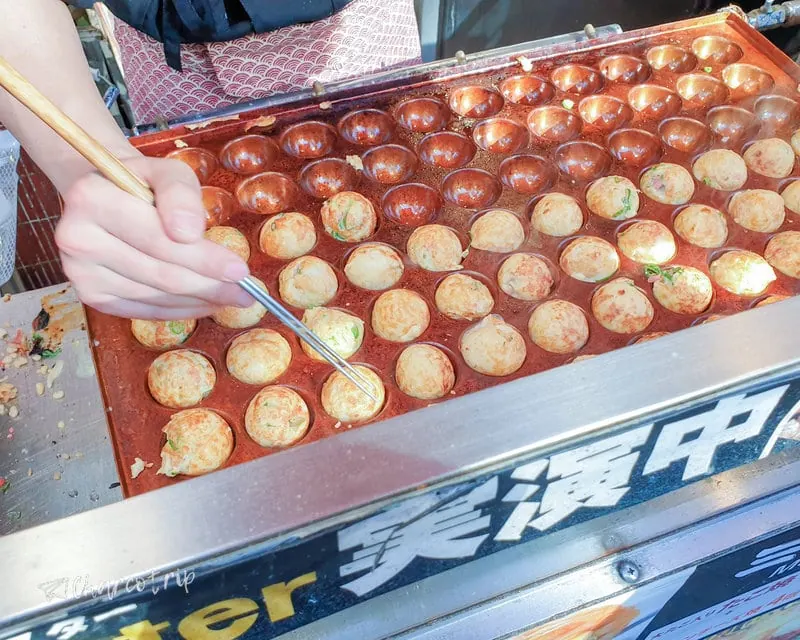

Typical food in Japan: complete meals
Yoshinoya bowl
This is one of the main dishes of the Yoshinoya chain, easy to distinguish with its green and orange signs, it is gyūdon which is a beef bowl consisting of a bed of rice with minced meat and onions on top. As a side come green onions, egg and miso soup.
In my case, I have also eaten this menu for breakfast. Delicious.
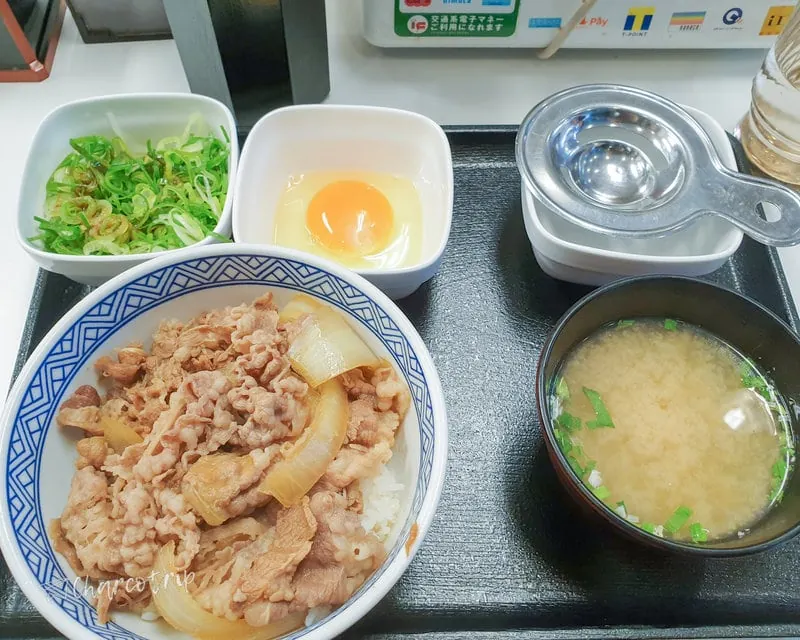
Kamaage udon (釜揚げうどん)
In Kamaage udon, thick, chewy udon noodles are served in a bowl with some very hot water, and the dish is always accompanied by a spicy sauce (dashi tsuyu) in another bowl next to it. To eat it, you have to dip the enormously long udon noodles into the sauce.
The sauce that accompanies it can be seasoned with ginger and green onions, they put them there, and you decide whether to mix it with the sauce or not. It should be noted that noodles should be slurped out loud if you want to eat kamaage udon in the most authentic way, remember that slurping noodles is one of the things done in Japan that many people don’t know about.

Tonkatsu (とんかつ)
Tonkatsu is a deep-fried pork cutlet, usually served with a side of shredded cabbage and tonkatsu sauce. This classic dish dates back to the 19th century and has remained popular with locals and tourists alike!
Tonkatsu can be found on any menu in Japan, but if you want to eat something exceptional, head to one of the many restaurants dedicated exclusively to this dish, it was in one of these places that I discovered how delicious the combination with ground sesame seeds is. Another combination of tonkatsu is with curry, like the one in the photo.

Soba (蕎麦)
Soba noodles are made with buckwheat flour and wheat flour, they are a staple of Japanese cuisine. They are usually served in a light broth or sauce, with sides such as tempura and vegetables.
They can be eaten wether hot or cold, the one in the photo is the cold version, and they are typically eaten for lunch and dinner by the Japanese population.
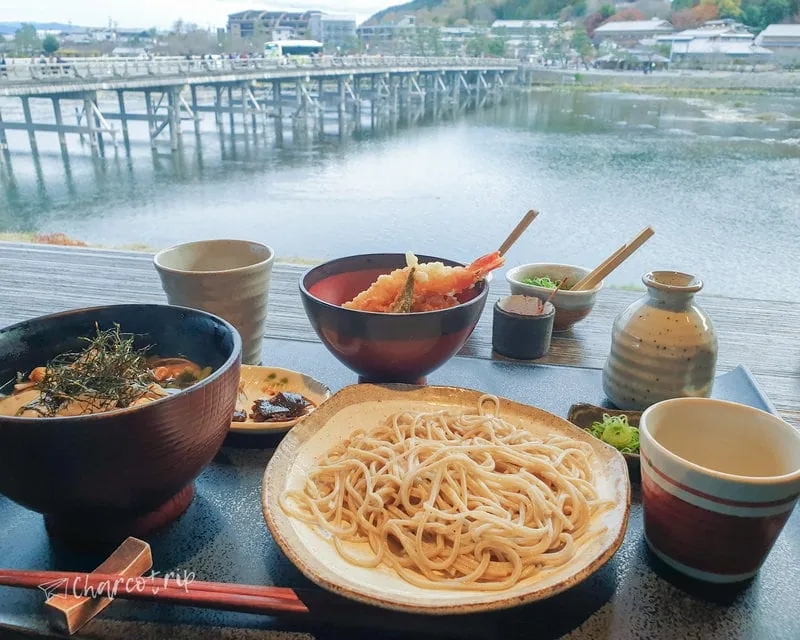
Sushi (すし)
When you think of “typical food in Japan”, perhaps the first thing that comes to mind is sushi, which is a traditional Japanese dish that consists of rice cooked in vinegar combined with other ingredients such as seafood, vegetables, and sometimes tropical fruit.
There are countless varieties of sushi available throughout Japan, each with its own unique characteristics and flavors. From simple cucumber and avocado maki rolls to more complex creations like rainbow rolls or dragon rolls, there is something for everyone.
You can not only enjoy delicious sushi at restaurants across the country and revolving sushi bars, but also at street stalls or even convenience stores. With so many options available, eating different types of sushi while exploring Japan is an absolute must!
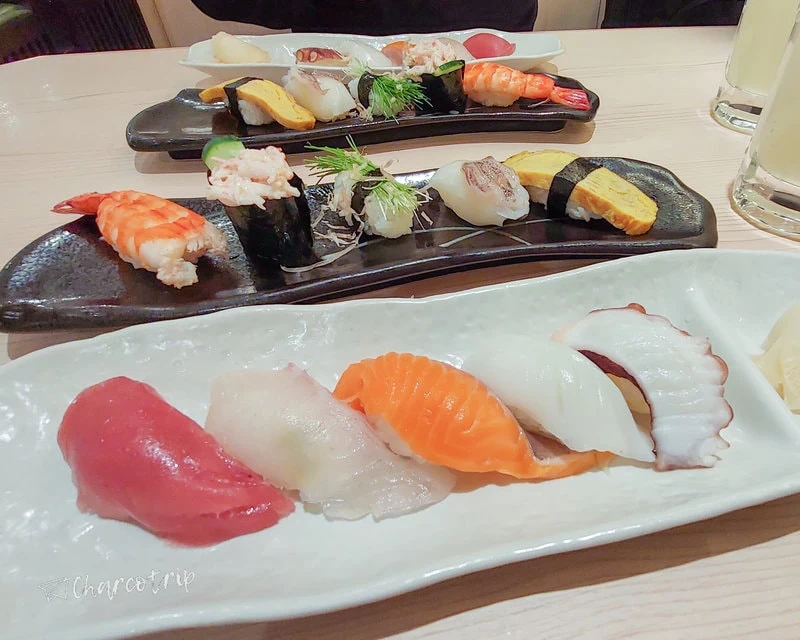
Shabu shabu (しゃぶしゃぶ)
This classic dish is made with thinly sliced beef cooked in a hot pot with simmering dashi broth and served with a variety of fresh ingredients such as mushrooms, onions, and cabbage.
The name “shabu-shabu” actually refers to the sound made when you stir or “shabu-shabu” the meat in the broth as it cooks. As simple as it sounds, this dish has become an integral part of modern Japanese culture, from family dinners to social gatherings, and you’re sure to enjoy it a lot. Of course, it must be considered that the budget for this meal is a little more expensive.


Omurice (オムライス)
Omurice is a popular Japanese dish that can be found all over the country. It consists of fried rice seasoned with ketchup and wrapped in an omelette. The combination of flavors makes this dish a favorite among all and can be seen in maid cafés among other places.

Kishimen (きしめん)
If you visit Nagoya don’t miss the kishimen, this noodle dish is made with thick, flat wheat noodles and served in a flavorful broth. The noodles are usually topped with a variety of ingredients including pork belly, green onions, fish flakes, and seaweed for added flavor.
Whether you’re trying it as part of a larger meal or as a main course, kishimen is sure to delight your taste buds, we loved it!

Sukiyaki (すき焼き)
Delicious sukiyaki is a hot pot of thinly sliced beef, vegetables and noodles cooked in a sweet soy-based broth, it’s the perfect comfort food on cold winter nights. Not only is it delicious, but the communal nature of preparing sukiyaki around a table makes it an ideal meal to share with friends and family.
The key to making authentic sukiyaki lies in finding the right combination of ingredients, from konnyaku (yam cake) to shirataki (long, thin noodles), that will make each bite as tasty as the last.
On several occasions, I celebrated my birthday with this dish in its version of “seeing how the ingredients are cooked on the table”. Although you can also eat the fast version in some restaurants that already bring you everything cooked and ready to eat.
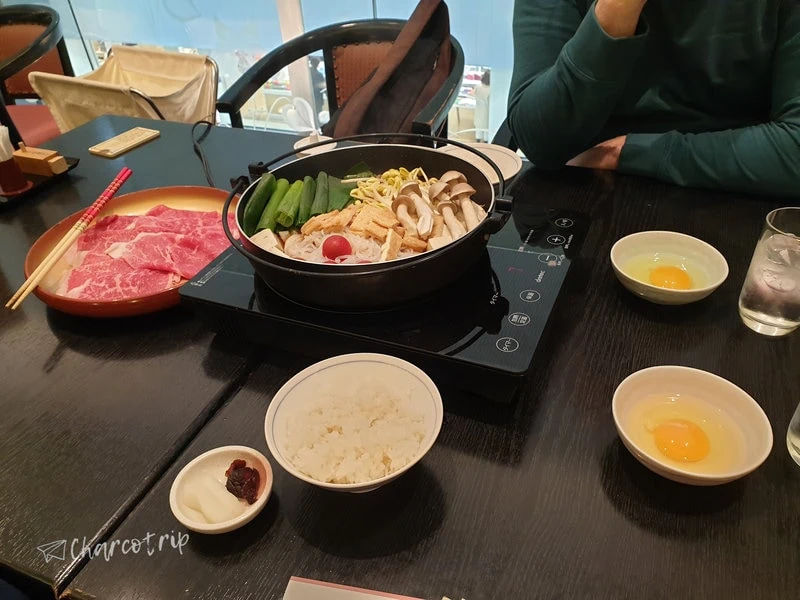
Skewers (くし)
Skewers, or kushi, can be found in street stalls, restaurants, among other places. It is made with skewers of seafood, meat or vegetables that are grilled over charcoal, which gives it a wealthy smoky flavor.
Skewers are very popular in Japan and are characterized by their versatility; there are countless variations on this classic to suit any palate. From simple teriyaki chicken skewers to more complex combinations like beef and mushrooms, it has something for everyone, some skewer will please you.
Whether you’re looking for a light snack or a hearty meal, kushi is sure to fulfill your cravings!
One of the memorable places where we ate skewers was in Fukuoka, where we could go to a yantai with our friends.

Mazesoba (まぜそば)
Here another noodle dish to the list, mazesoba, a delicious Japanese noodle dish, is undoubtedly one of the delicacies that you must eat when traveling to Japan. It is a mix of ramen and tsukemen noodles with a variety of toppings such as fish flakes, pork slices, bean sprouts, and green onions. It is served in a thick pork or fish-based broth that has been simmered for hours to bring out its distinctive umami flavor.
The best way to enjoy mazesoba is by mixing the broth and noodles together until well combined. Depending on your preferences, you can add different ingredients such as boiled eggs, seaweed or mushrooms to give it more flavor.

Yakiniku (焼き肉)
If you’ve seen a few episodes of Naruto, you’ve seen the Ino-Shika-Chō team eat with their sensei, who in the end had to pay for the grilled meat, poor guy. It is about yakiniku, which translates as “grilled meat”, and is generally prepared on charcoal or gas grills.
Yakiniku consists of thin slices of beef, pork, or chicken that are marinated in a sweet and savory sauce before being cooked to perfection. It can be served as a main course with side dishes such as rice, noodles, or vegetables; or it can be served alone as an appetizer.
As a curious anecdote, I have to say that this was one of the places where, to our surprise, there was no menu in English. But it wasn’t that difficult to order our meat, which, by the way, was delicious. Of course, it must be considered that this type of food is expensive, as it is almost pure meat.
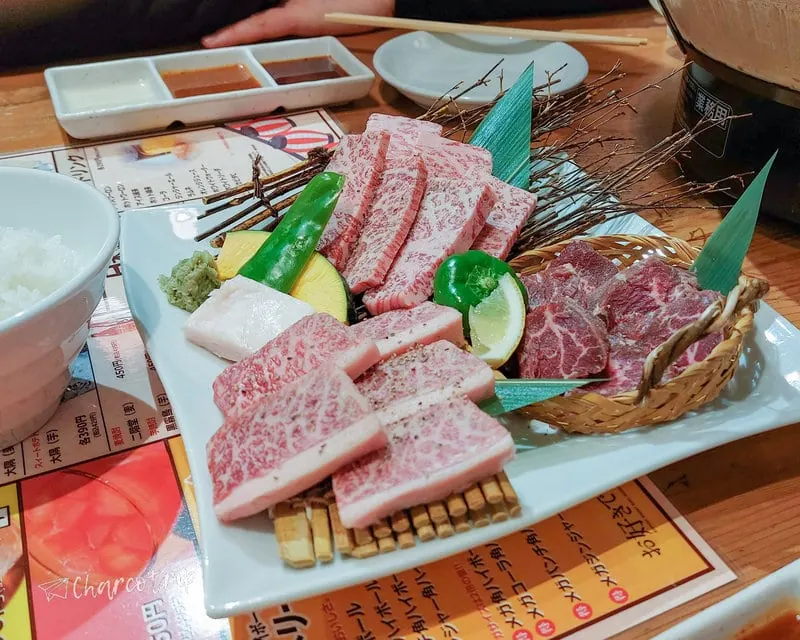
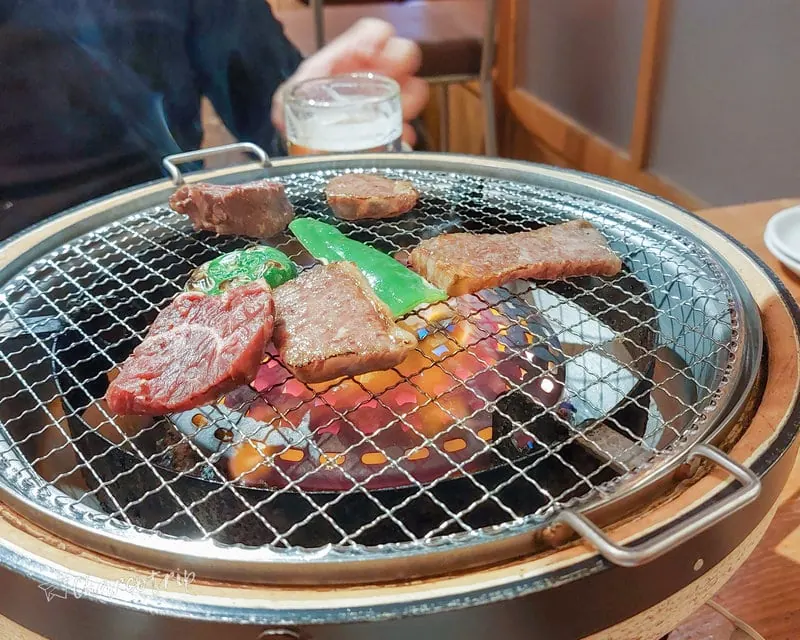
Kobe beef (神戸ビーフ)
Damn, I think that if I told you that both shabu-shabu, sukiyaki and yakiniku are expensive because they are meat, we have reached the king in terms of price, but also in terms of flavor.
I had already heard that Kobe beef was the best in the world, and I honestly thought that was a pure cliché.
But, no, it’s not. It is the plain truth.
After eating this meat, you will wonder how you can continue eating the meat that you buy in the supermarket?
Kobe beef is produced from black Wagyu cattle fed a special diet that includes sake and beer. The result is an unforgettable dining experience that can be found in many restaurants across the country. Kobe beef can also be enjoyed as shabu-shabu or teppanyaki dishes, both of which involve cooking on a griddle or iron skillet.
This dish comes highly recommended by locals and tourists alike due to its unique flavor profile and luxurious texture, something you won’t want to miss when traveling to Japan! (yes, consider that a fairly high budget is needed).

Udon (うどん)
Udon is a type of thick wheat flour noodle, often served hot in a mild fish broth with various toppings, such as tempura or seafood. It can be enjoyed in many ways, whether chilled, with a dipping sauce, as part of an elaborate meal, or as street food.
It was invented in the 6th century and has become loved across the country due to its versatility and delicious taste. It’s a whole new dimension of traditional noodles!
And just like with soba noodles, you have to slurp when eating to dissipate the heat. Don’t be ashamed!
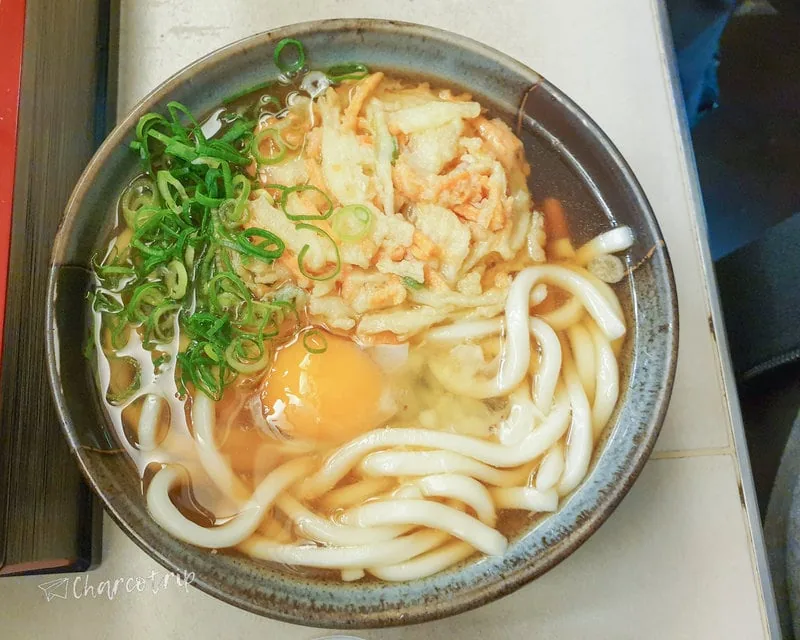
Monjayaki (もんじゃ焼き)
Monjayaki is a kind of Japanese cake that is popular in Tokyo and the surrounding Kanto region. A popular street food, this dish has been around since the Meiji period, known as a snack called Mojiyaki.
Monjayaki is made from dough that is mixed with shredded cabbage and other ingredients such as seafood and pork. The mixture is cooked on a hot teppan grill before being served with dipping sauces. The result is an incredibly flavorful dish that can be enjoyed as an appetizer or as part of a larger meal.
In the restaurant, do not hesitate to ask the staff to prepare it for you, they have asked us if we do it, or they do it, for now, we continue to answer that they do it because we still do not feel confident doing it.
Maybe on our next trip to Japan we will dare to eat a monjayaki made by ourselves.

Tsukemen (つけ麺)
Tsukemen is a unique type of Japanese noodle dish that has gained international popularity over the years. It consists of thick, chewy noodles that are served separately from a savory sauce, which can be spicy.
The combination of cold noodles and hot sauce creates an interesting flavor contrast that I love. In addition to the pasta and broth, it is served with chashu pork, which is cooked in soy sauce. We explain more in this article dedicated to tsukemen.



Okonomiyaki (お好み焼き)
Okonomiyaki literally translates as “cook to your liking” and is one of the most popular and social Japanese dishes since you meet and eat around the griddle.
It is a type of savory cake made with flour, grated yam, eggs, cabbage, and other ingredients such as seafood or meat. It can also be garnished with a variety of seasonings including mayonnaise, soy sauce, and fish flakes for added flavor.
As with monjayaki, if you don’t know how to make it, don’t be embarrassed and ask the restaurant staff for help.

Kamameshi (釜飯)
Kamameshi (literally “boiling rice”) is a classic Japanese dish in which steamed white rice is combined with vegetables, fish, mushrooms or meat; the resulting mixture is placed in an iron pot and simmered until it reaches the perfect consistency.
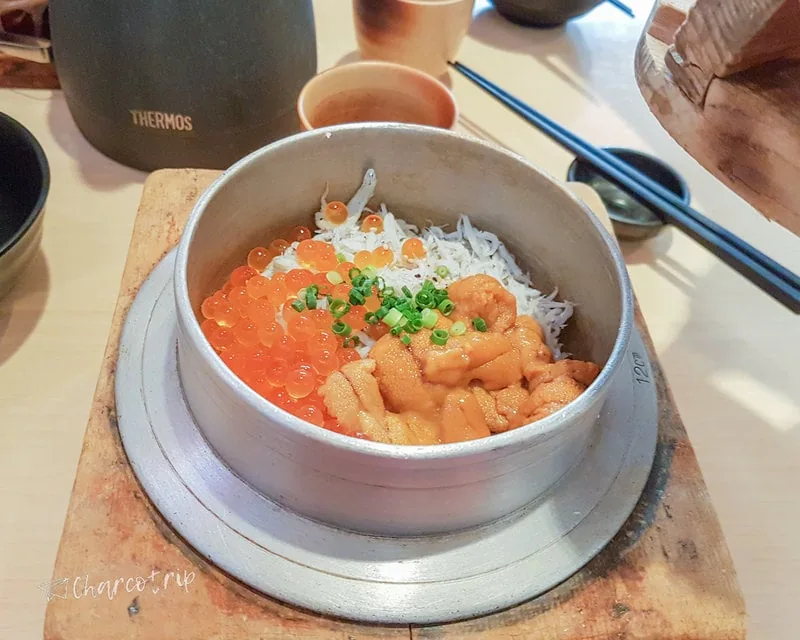
Kushikatsu (串カツ)
Kushikatsu is a popular Japanese delicacy that has been enjoyed in the country since the mid-19th century, it originates from Osaka, the Shinsekai neighborhood to be more precise. It consists of fried food on skewers, usually made of meat, fish or vegetables and is usually eaten in special restaurants called kushiage restaurants. One of the most famous chains in Osaka is Daruma.
Kushikatsu is often served with a variety of dipping sauces and accompanied by coleslaw or other garnishes such as French fries or boiled potatoes.
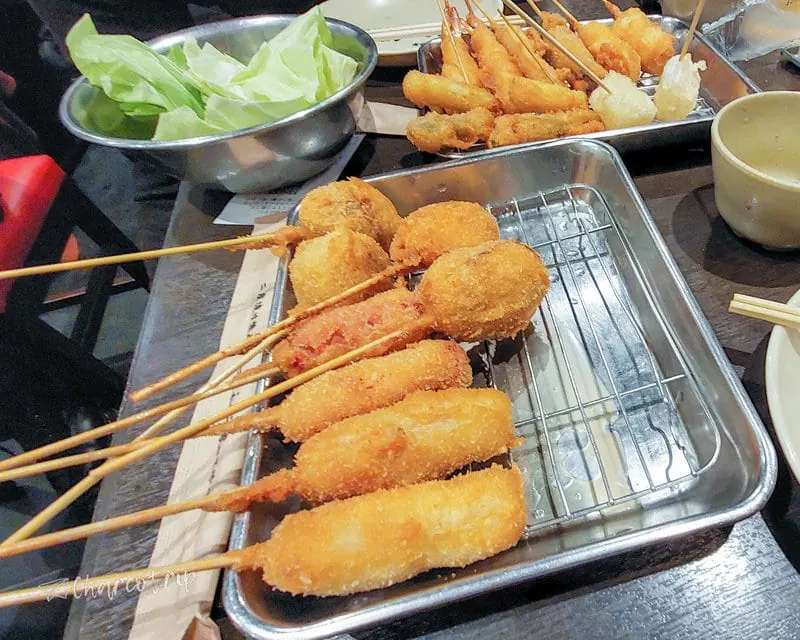
Curry (カレー)
Japanese curry was introduced to Japan by the English during the Meiji era, while India was under British administration. This delicious dish is made with a combination of vegetables, meat or fish and spices simmered in a thick roux-based sauce (curry powder, flour and oil, along with other ingredients). The delicate balance of flavors creates a rich and substantial meal that will not leave you indifferent.
As a reference for Mexicans: it will remind you of mole.
Nowadays, you can find variations on the classic dish depending on where you’re eating, from vegan options to more robust entrées loaded with red meat or tonkatsu!
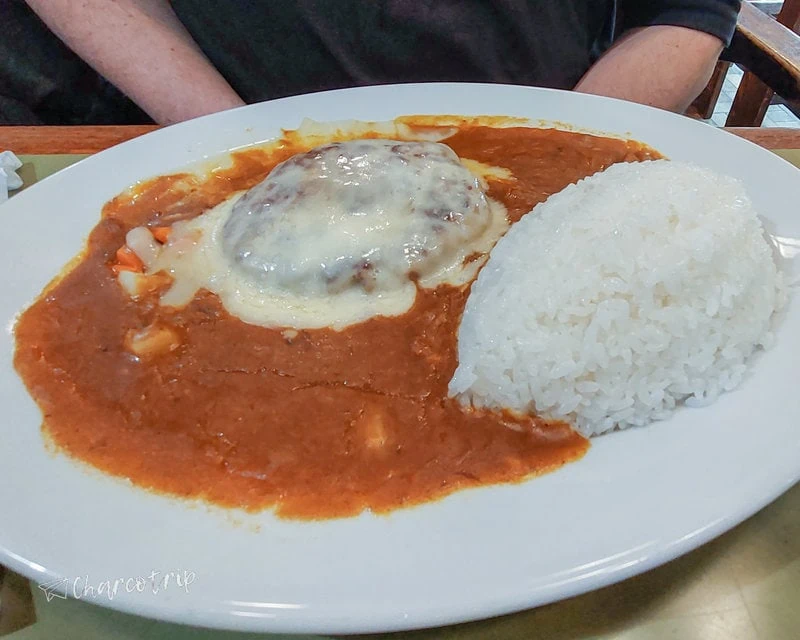
Ramen (ラーメン)
Something you shouldn’t miss for any reason on your trip to Japan is ramen! It is a very popular national dish and can be found on menus across the country. A traditional bowl consists of wheat noodles in a hot broth that is usually made with soy sauce, pork bones, just salt, or miso, and is usually topped with pork, seaweed, green onions, and other delicious ingredients.
What makes ramen such an enjoyable meal is its versatility; there are countless variations depending on the region you visit. From Hokkaido miso ramen to Kyushu-style tonkotsu, you’ll find a unique flavor at every turn!
Make sure you eat as many different styles as possible to get a real taste of Japan. If you are not going to move around the country during your trip, do not worry! You can go to the Ramen Museum in Yokohama and eat a wide variety of ramen from all over Japan.
Here in the photos you can see different types of ramen, from shoyu (soy sauce), miso (fermented soybean paste), yonkotsu (pork bones) to shio (salt).

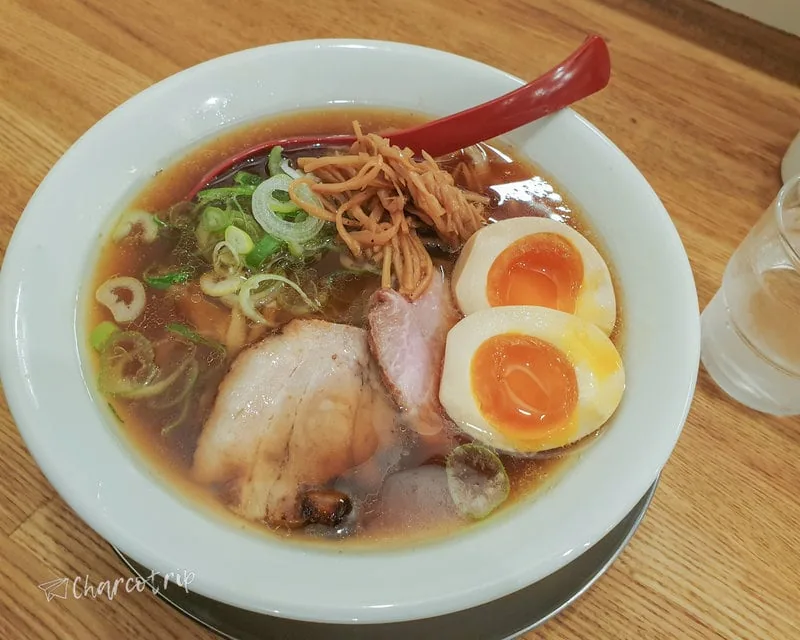
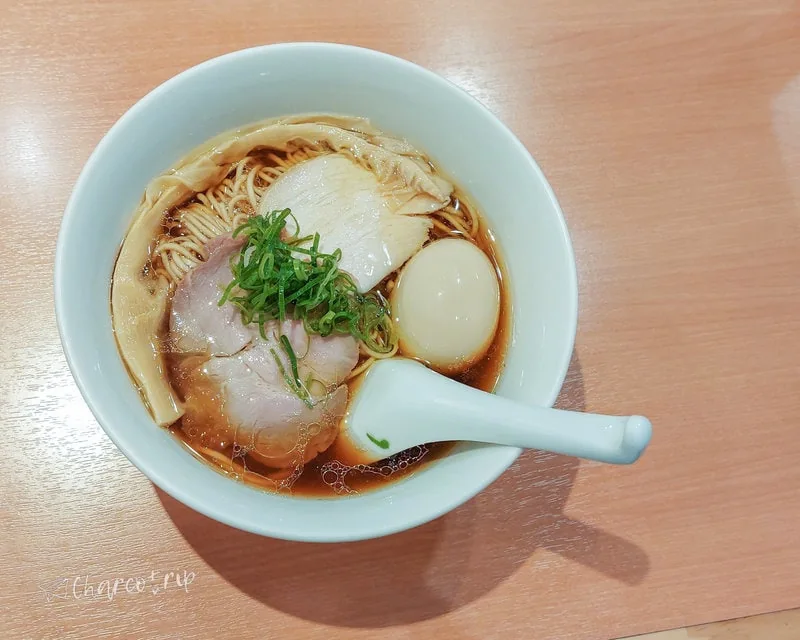


Spicy (or very spicy) ramen
In several places, you can find ramen that goes from spicy to very spicy. I want to make a special mention of this ramen from a chain called Kikanbo, which is located in Tokyo. We tell you about the experience of eating in this place here.
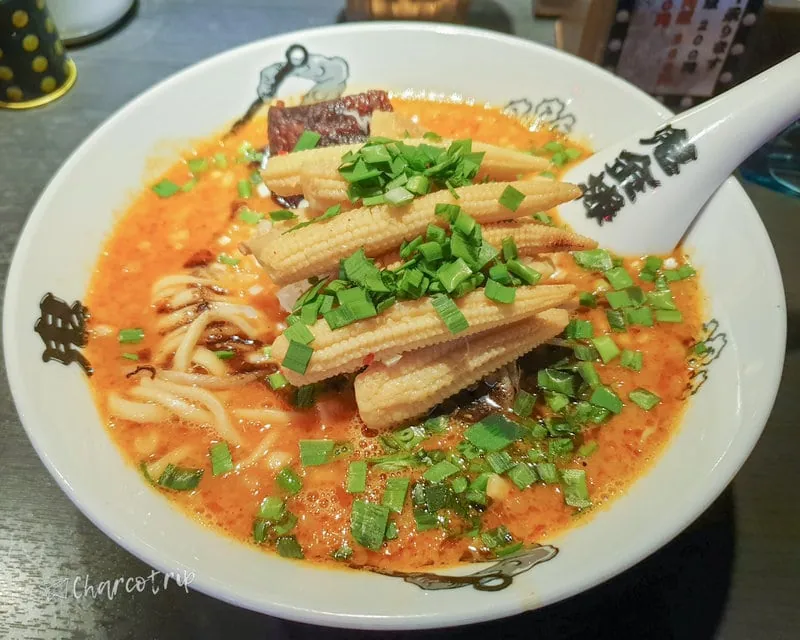
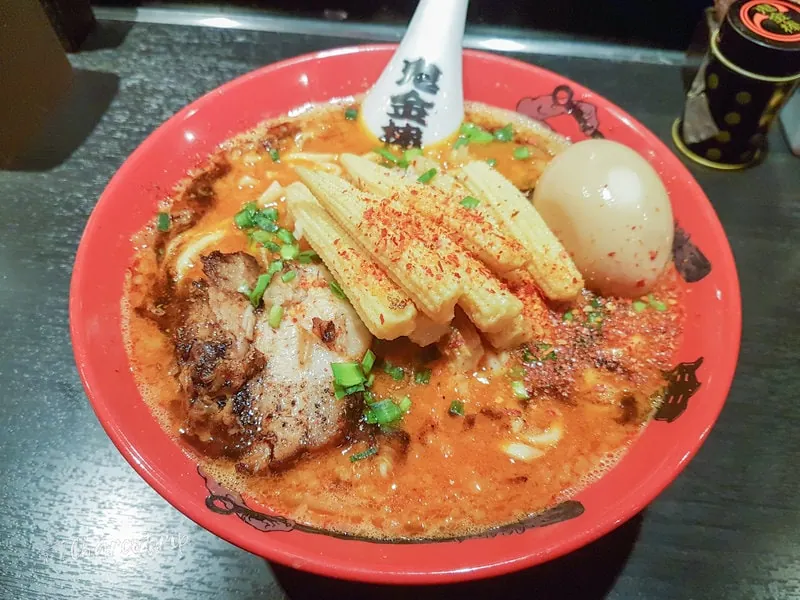

Themed meals
There is another type of food that is not necessarily the tastiest, but it is the most beautiful. In Japan, we can eat in a wide variety of themed restaurants and cafés, and who says themed restaurant means themed food and drinks.
As a result, we have a Rilakkuma rice or a Pikachu omurice, among other cuties. The hard thing will be to eat something so beautiful.
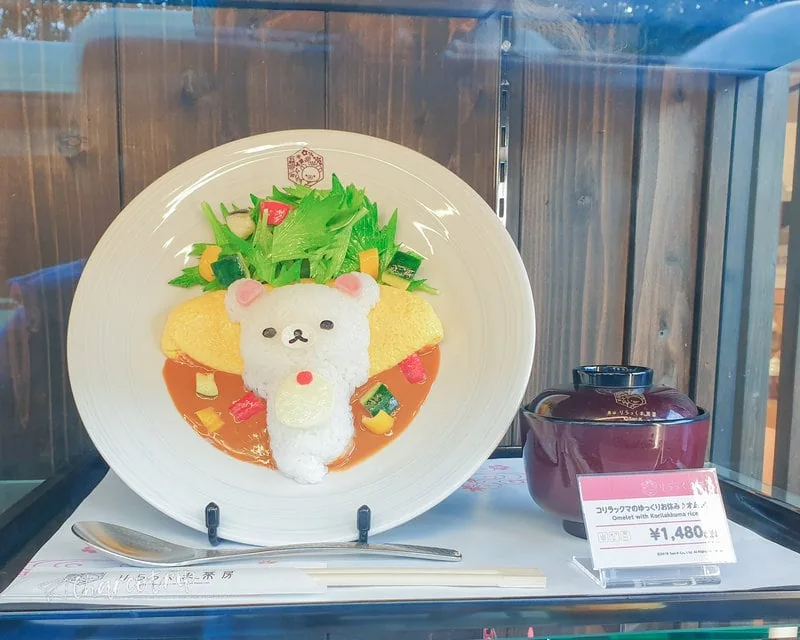

Teishoku
Another style of food, more typical, food that tells you “you are in Japan!”, but equally beautiful, is teishoku which consists of a main dish accompanied by side dishes such as miso soup, pickles and rice.
It is served on a tray, with each item carefully prepared and arranged for an irresistible presentation.
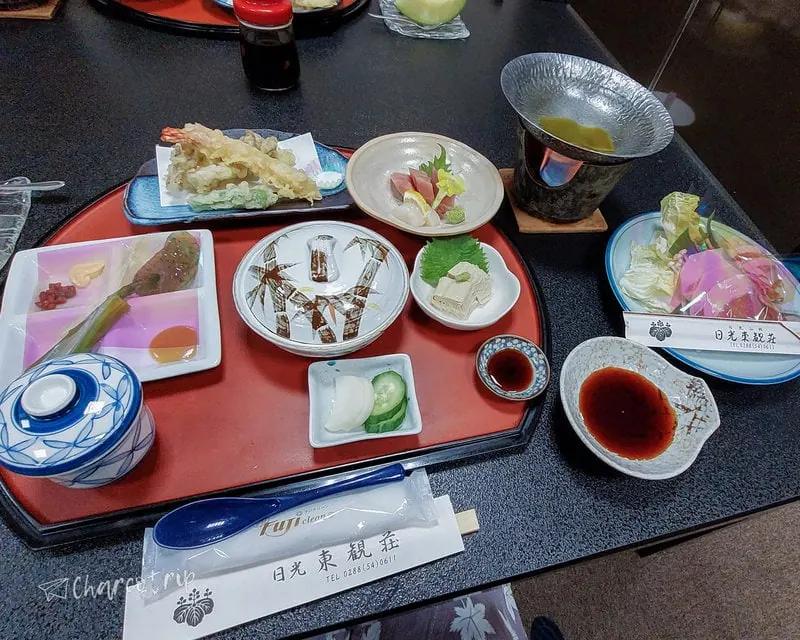
Desserts that you can try in Japan
Fluffy pancakes (スフレパンケーキ)
In Japan, you can eat these tall pancakes, they are called fluffy because they are fluffy and look like little pillows. They can be accompanied by fruit or ice cream in flavors as diverse as green tea.
We recommend the fluffy pancakes at Hoshino coffee.
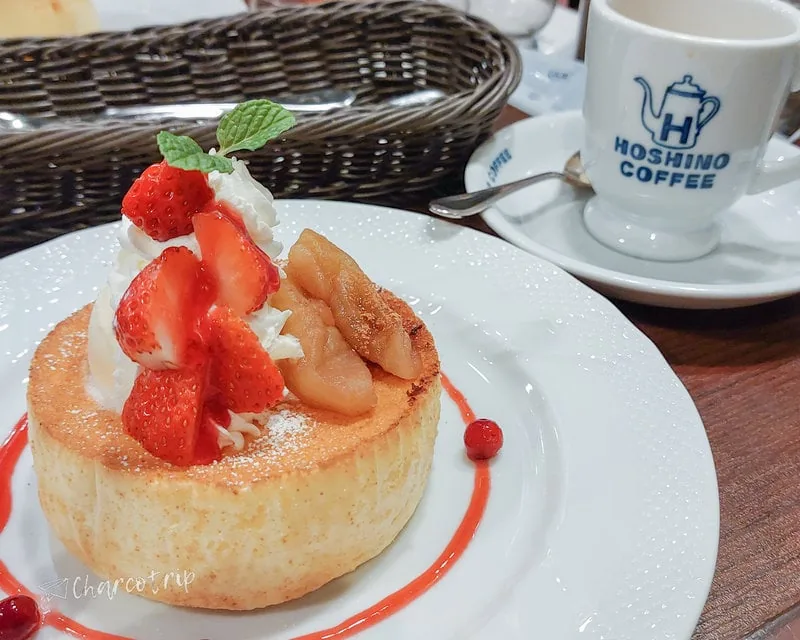
Mochi (もち)
Mochi is a popular Japanese dessert that has been around for centuries. It is made from short-grain glutinous rice that is pounded into a paste and then shaped into small, round shapes.
The texture of the mochi is slightly chewy, but very nice. One of the most popular presentations is the daifukumochi which is a stuffed mochi ball, it can be chocolate, strawberry, etc.

Dango (団子)
A derivative of mochi is dango, which is made with mochiko. These are very popular skewers in Japan (and if you have seen the Naruto series, you will have seen them being eaten with pleasure by the anime characters).
They can be easily purchased on the street, here Vicente ate a skewer while we were on Miyajima Island.
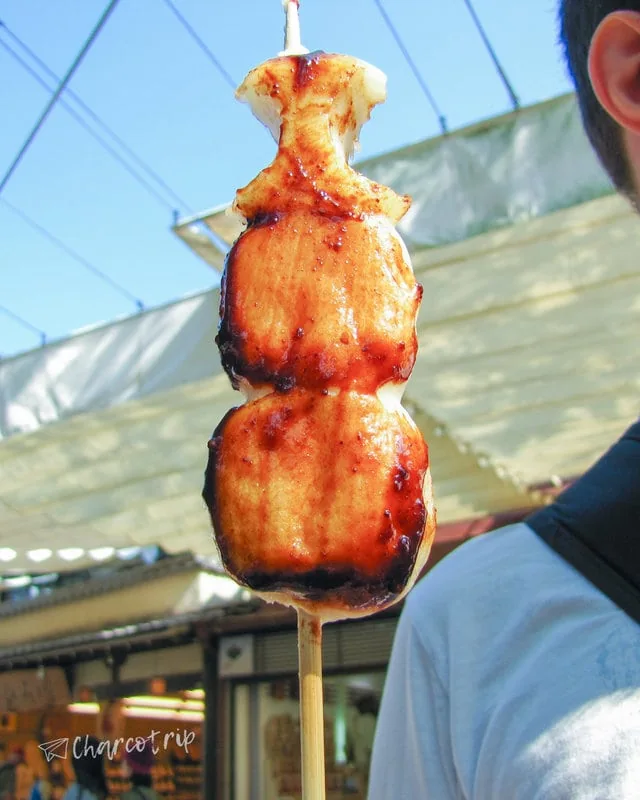
Themed desserts
Of course, if you can have a themed meal, dessert will not be left behind. You can also easily enjoy desserts in the shapes of your favorite characters.
The hard part will be eating them.
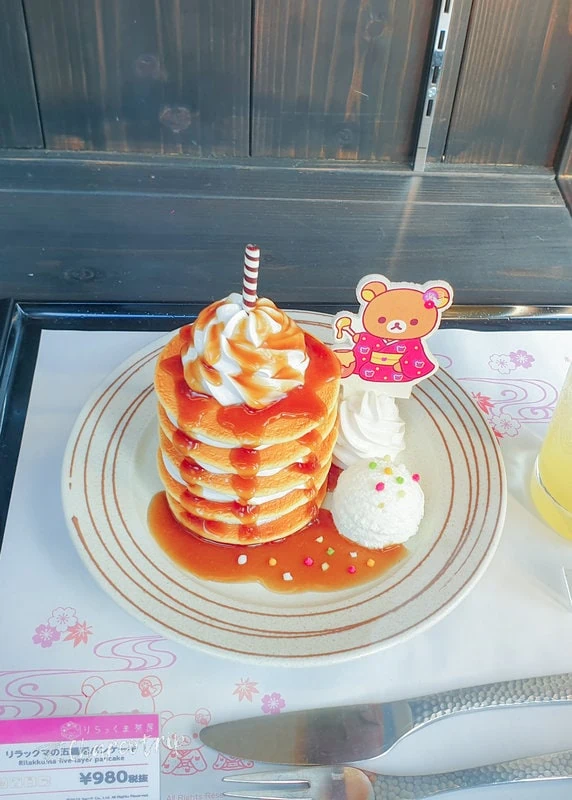
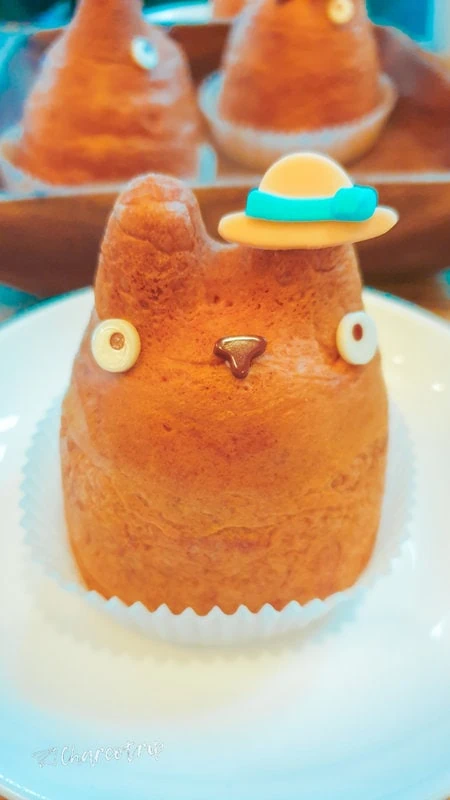
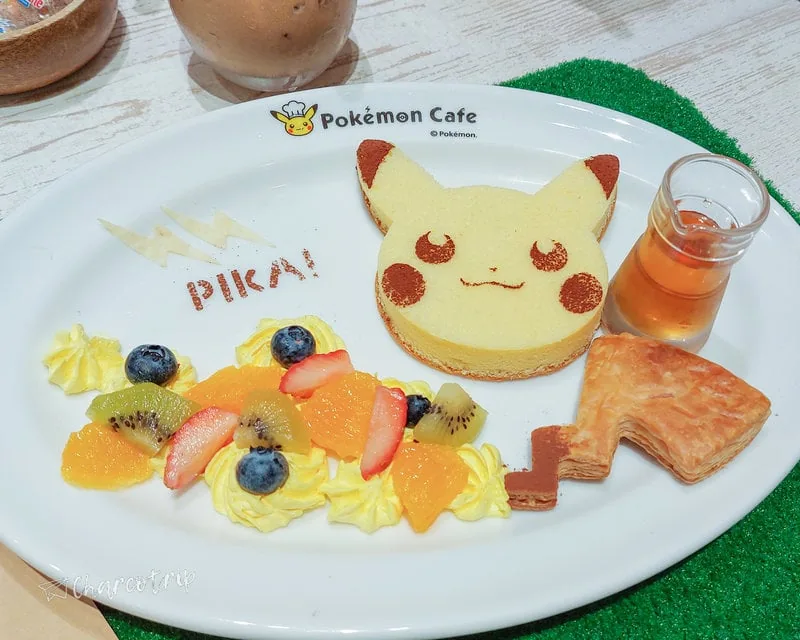
Momiji manju (もみじ饅頭)
Momiji manju is a traditional Japanese dessert consisting of a soft steamed bun filled with a variety of fillings such as red bean paste, sweet potato, and chestnuts. It is typical of Miyajima Island, very close to the city of Hirosima, and is shaped like a momiji leaf, that is, a maple leaf.
In addition to buying it as a snack or for dessert, it is a perfect souvenir of your visit to this area.

Japanese Drinks
Sake (酒)
Sake is an important part of Japanese culture and cuisine. Made with fermented rice, sake has been produced in Japan for centuries and is the national drink of Japan, it can be enjoyed both hot and cold.
There are many varieties to choose from during your trip to Japan! To start with cold or hot, personally I like the hot version better.



Umeshu (梅酒)
If you’re looking for another drink option to try during your trip to Japan, why not try some umeshu? This traditional Japanese drink is made from fermented ume, shochu and white sugar. It has a sweet and sour taste and a light alcohol content of around 10%-15%.
When ordering an umeshu, you must also specify how you want it to be served. Some of the options are: mizuwari (with water and ice), umeshu rokku (on the rocks), umeshu sawa (sour), umeshu tonic (with 2/3 tonic) and umeshu soda (with 2/3 carbonated water)
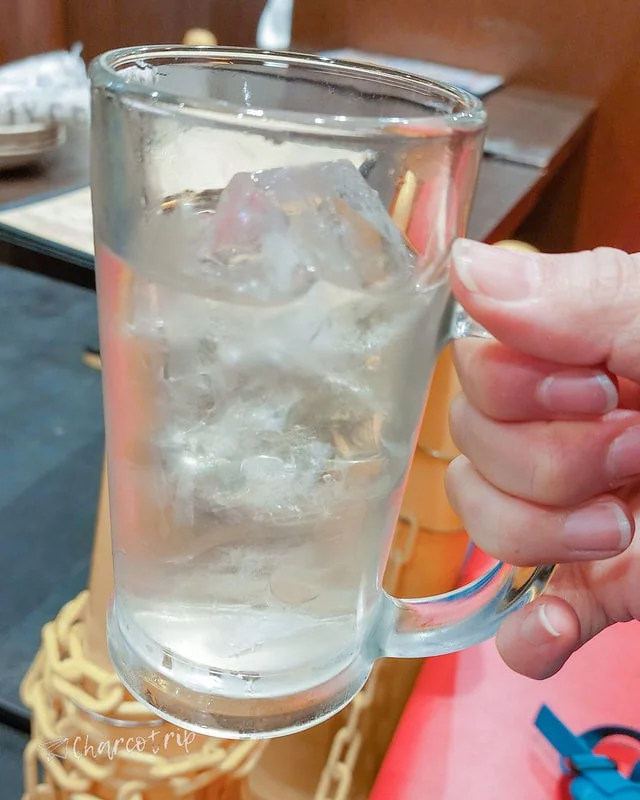
Themed Drinks
Again, in themed cafés when you order your food and dessert from your favorite characters, you have the opportunity to do the same with drinks. But then again, it will be difficult to take it down, as pretty as it is.

Theme and latte art cafes
One way to test yourself is with the enormous variety of themed, or even not necessarily themed, cafés that offer this type of coffee with what is known as “latte art”, that is, art in coffee.
The techniques can be very diverse but always with the same objective: make you feel sorry for having to undo it and drink your coffee.

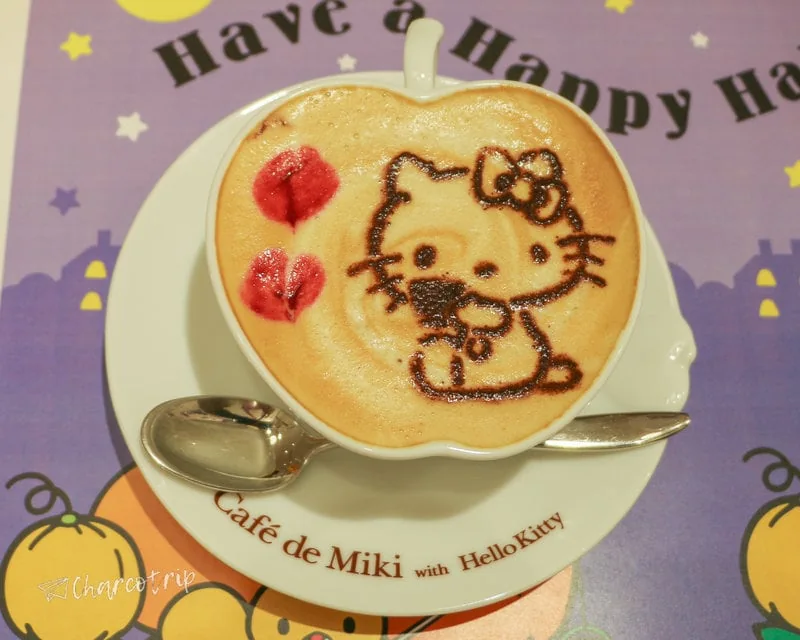
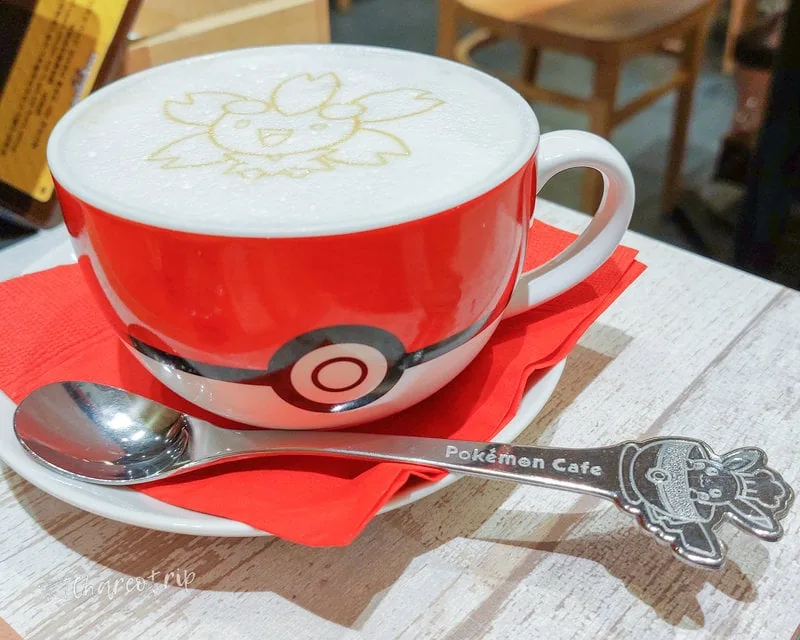
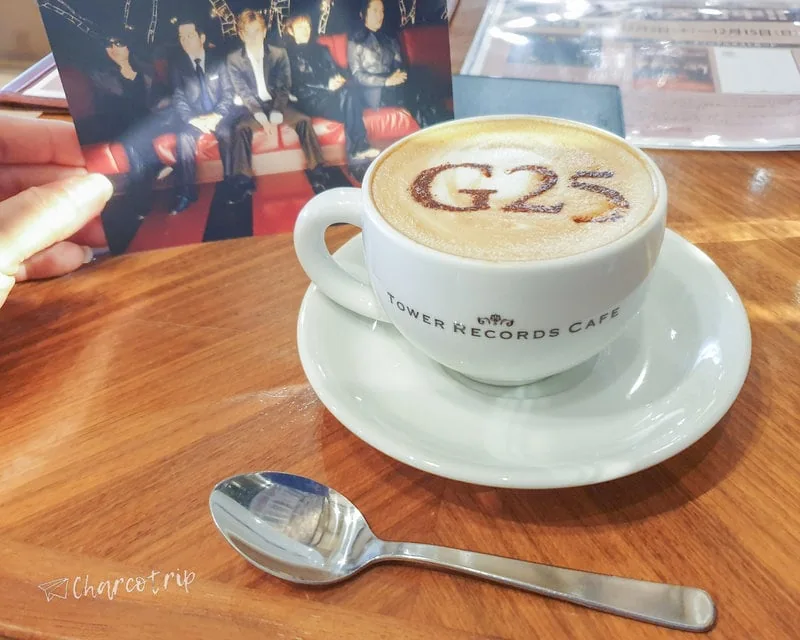
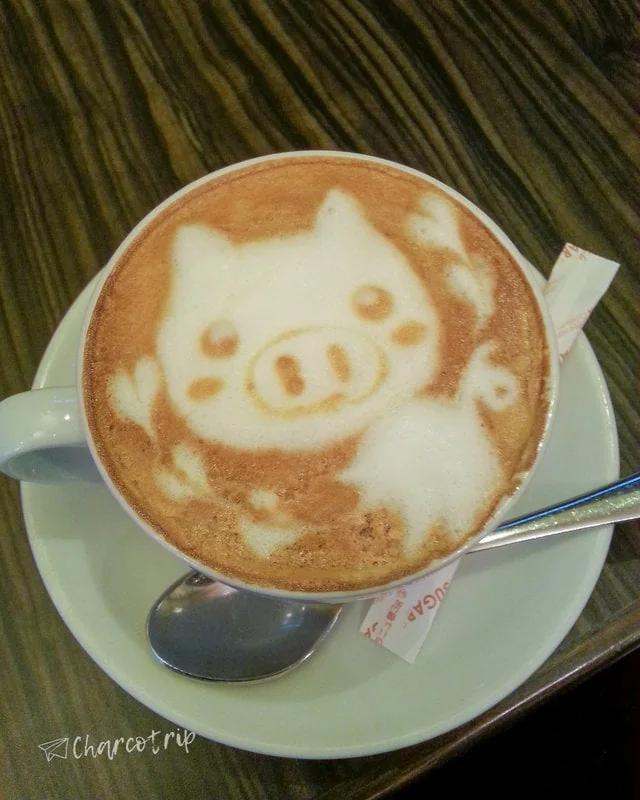
In conclusion, there is plenty of typical food in Japan, as it has many delicious dishes to offer travelers of all tastes. From fast or street food to a fancy restaurant, there are plenty of tasty options to try on your trip. And there is no need to fear the language barrier.
Even if you are not an adventurous eater, there will be something to entice and tempt your taste buds. So don’t be afraid to step out of your comfort zone and explore the culinary delights that Japan has to offer, you won’t regret it!
Enjoy your meal and happy travel!
Some of the links in this article include affiliate links. This means that if you buy a product listed here by following these links, we'll receive a commission. The use of this link does not increase the final price for you and thus helps us to keep our blog alive.



